Posted by Elena del Valle on June 29, 2009
Graphics: HispanicMPR, Vertis
For several years the media industry has been changing before our eyes. Slowly we witness a media revolution and evolution driven by outdated business models, the increasing availability of technology to an ever growing populace and consumers’ mistrust of conventional media as well as the desire of some consumers to be part of the machinery that informs and opines.
As one of the latest large waves of immigrants Latinos are a significant consumer market for media because the Hispanic market is young, comparatively speaking, and growing. The most recent arrivals often have their own cultural preferences for media consumption and may even prefer Spanish language or bilingual options. Many among the millions of Latino immigrants or children of immigrants, usually the most affluent and best educated, have acculturated and mimic mainstream consumers in their media consumption habits.
Some data, including a Vertis Communications 2007 telephone survey of 500 Hispanic adults, indicates Latinos may spend more time watching television and surfing the web than their counterparts among established and emerging markets. Respondents to that survey also were 44 percent more likely to be influenced by information they found online than the total United States population.
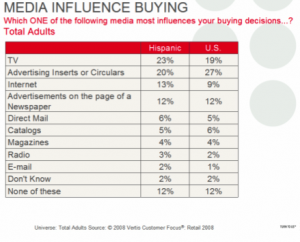
Although they may make many of their purchases offline they are likely to research choices, reviews and prices online before placing an order by phone or shopping in person. Vertis researchers concluded that Hispanic adult respondents were more likely than the overall population to buy consumer electronics, even when the economy was down. For example, 28 percent of Hispanics said they would buy a big screen or HDTV within 12 months while only 23 percent of non-Hispanics anticipated such purchases.
The survey also found that Hispanics with online access conducted the most internet research on electronics and clothing. At that time, 62 percent of Hispanics with internet access said they researched home electronics online prior to purchase compared to 59 percent of all United States respondents with internet access. Also, 38 of online Hispanics who participated in the survey said that they research clothes online before buying them compared to 30 percent of all online respondents.
The Vertis Customer Focus Opiniones survey is designed to track consumer behavior in retail, grocery, home improvement, fashion, home electronics, sporting goods, furniture, technology, auto aftermarket, financial and media such as direct mail marketing. The 2007 Opiniones survey conducted by Vertis was the most recent survey of that type conducted by the company, according to a company spokesperson.
Posted by Elena del Valle on June 26, 2009
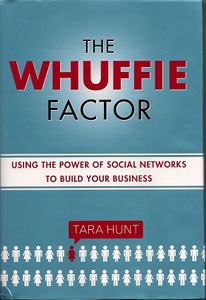
The Whuffie Factor book cover
While millions of people have online profiles and are active in well known social networking sites like Facebook and Twitter, reaping measurable advantages from the profiles does not necessarily follow. Some companies and individuals are convinced these networks are the future and that for those who know what to do and how to do it all the coveted goals will become a reality. As the social networking craze continues a wave of new experts is stepping up to the plate to share their insights with amateurs who want to build a business, develop their presence online or generate business benefits.
In The Whuffie Factor Using the Power of Social Networks to Build Your Business (Crown Business, $25), a 312-page hardcover book published in 2009, Tara Hunt, who has spent the past 15 years participating in or building online communities addresses how-to and best practices issues. She titled the book for the word “whuffie” which refers to the social capital of a person based on his or her actions and contributions to a community and what other people think of him or her.
The book is divided into 10 chapters: How to Be a Social Capitalist, The Power of Community Marketing, Turn the Bullhorn Around and Create Continuous Conversations with Customers, Building Whuffie by Listening to and Integrating Feedback, Become Part of the Community You Serve, Depositing into and Withdrawing from Your Whuffie Account, Be Notable: Eleven Ways to Create Amazing Customer Experiences, Embrace the Chaos, Find Your Higher Purpose, and Whuffie IRL.
Hunt, also known as Miss Rogue, co-founded Citizen Agency, a San Francisco community marketing consulting firm. She now leads the marketing efforts of Intuit’s partner platform.

Click here to buy The Whuffie Factor
Comments:
Filed Under: Books
Posted by Elena del Valle on June 24, 2009
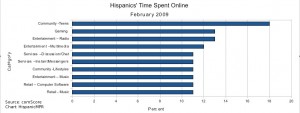
Hispanics
For companies targeting online audiences Latinos represent a booming market with continued potential for growth. As of February 2009 there were 20.3 million Hispanics or 11 percent of the total United States online population and a record number, according to comScore, Inc., a company that measures the digital world. As a greater number of Hispanics went online in the past year, the U.S Hispanic Internet audience grew faster than the total U.S. online population in terms of number of visitors, time spent and pages consumed.
At the same time, some believe effective targeting of the Latino online market requires knowledge and finesse to push the hot buttons that will prompt loyalty and purchasing responses from the highly diverse and demographically young audience. The days of viewing ethnic markets through a uni dimensional single scope are past. Just as translating materials as the sole method of addressing the highly desirable Hispanic market, online and offline, is no longer considered sufficient or in some cases even appropriate (when targeting English dominant Latinos for example).
“It’s well known that the Hispanic market is a growing and increasingly important segment to advertisers and marketers,” said Jack Flanagan, executive vice president of comScore Media Metrix. “However, any business attempting to effectively reach this segment needs to understand the behavior of the U.S. Hispanic online consumer as a fundamental component of their marketing and media strategies.”
Some are convinced the Hispanic market is diverse and distinct from the general market. Given the increasing number of new Latin consumers and their desirable purchasing habits even if that market segment requires extra attention, dedicated or customized campaigns it may prove a worthwhile investment for savvy businesses in the long term.
“As most people know, US-H (US Hispanics) currently represents 15 percent of the total US population and it is estimated to grow up to 20 percent within the next 10 years, half of them are online and this number will only grow. The fact is that even thought we are still a minority, we are definitely a minority that can not be underestimated, not only because of the massive number of potential costumers that we represent, but because our habits significantly differ from those of the US General market users, and more importantly, because our purchase behavior is way more apealing than the US General market users,” said Joel Bary, chief executive officer, Latin Medios.
“We, the online Latinos, have a higher household income than any other online users group in the US, and simply put, we buy more than any other group, so we make a very interesting and potential costumer base that can not be ignored. The marketplace is no longer a single group one, it is now composed of several major groups that will need to be addressed in a special and direct way, other ways, a segment of this marketplace will not respond to the message and will be left araw to be picked up by the competition.”
In 2009, Hispanics’ time online increased 6.9 percent (3.9 times faster than the total U.S. online population), while total pages consumed grew 6 percent (3.6 times faster than the total U.S. Population).
“The Hispanic online market is growing faster than the general market, not just in terms of gross number of users but also in other measures that are important to marketers like time spent online. Advertisers are taking notice too: While categories like Automotive, Wireless, and Credit Cards have been on board since the early days of Hispanic internet, more recently we’ve noticed growth coming from other important categories like Food, Retail, Insurance, and Personal Care Products. That’s especially important now that the automotive and credit card categories are down,” said Carlos Pelay, president, Media Economics Group.
“Just in the Food category, for example, we’ve seen some major companies making their first forays into the Hispanic online market in 2009. Companies like Birds Eye Foods (BirdsEyeenEspanol.com), General Mills (“Nature Valley”), Hershey (“Hershey’s Kisses” sweepstakes on Univision.com) have advertised on Hispanic sites for the first time this year. Significantly, these three companies are running Spanish-language campaigns on Spanish-language Hispanic websites.”
Researchers looked at the site categories where Hispanics spent an above average share of their online time. The most popular categories were Community – Teens, where U.S. Hispanics accounted for 18 percent of total time spent in the category; Gaming Information at 13 percent; entertainment and leisure including Radio (13 percent), Multimedia (12 percent), Discussion/Chat, Instant Messengers (11 percent) and Music (11 percent).
Reach Hispanics online today with
“Marketing to Hispanics Online” audio recording
Identifying and characterizing the booming Hispanic online market



Joel Bary, Alex Carvallo and Matias Perel
Find out about
• The 16 million Latino online users
• Latino online users by gender
• What they do online
• Their language preferences
• How to reach Hispanic urban youth online
• What affects their online behavior
• What influences their purchases
Click here for information about “Marketing to Hispanics Online”
Posted by Elena del Valle on June 22, 2009

Craig Handley, CEO, Listen Up Espanol
A podcast interview with Craig Handley, founder and chief executive officer of Listen Up Español, is available in the Podcast Section of Hispanic Marketing & Public Relations, HispanicMPR.com. During the podcast, Craig discusses how to pick a U.S. Hispanic call center with Elena del Valle, host of the HispanicMPR.com podcast.
Craig leads Listen Up Español, a near-shore Spanish language call center, and its sister enterprise, Revenue Enhancement Consultants (REC), which supports the work of service providers and affiliates.
He started his career in door-to-door sales and rose through the ranks in several call centers. A consultant for hundreds of products and services he has contributed articles to Response Magazine, eRetailer and DM News on how to effectively increase revenue and profitability.
Craig served in the U.S. Army, and studied music as a vocal major in college. These days, his passion for music is often displayed as one-half of the hip-pop duo CR Gruve.
To listen to the interview, scroll down until you see “Podcast” on the right hand side, then select “HMPR Craig Handley” click on the play button below or download the MP3 file to your iPod or MP3 player to listen on the go, in your car or at home. To download it, click on the arrow of the recording you wish to copy and save it to disk. The podcast will remain listed in the June 2009 section of the podcast archive.
Posted by Elena del Valle on June 19, 2009
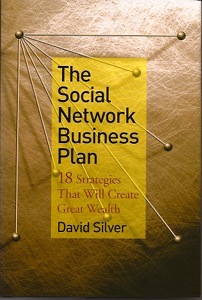
The Social Network Business Plan book cover
In spite of the popularity of social networks in the last years, from a business perspective the question many investors are asking is whether they make business sense. Since social networks are free to users in order to become financially viable they must generate revenue from another source. Many believe the traditional media model that offers advertising space to support editorial content is the key. Others question the effectiveness of ads in the social network pages. In The Social Network Business Plan 18 Strategies That Will Create Great Wealth (Wiley, $24.95), a 191-page hardcover book published this year, David Silver says there is another way.
According to him social networks are the biggest thing since the development of bread 6,000 years ago; and the social networks that prompt consumers to try out, rank and recommend products and services are a revolutionary marketing tool that will create a huge disruption in the way we do business today. He promises readers that through his book they will discover how to create an online recommender community, a new way to launch products and services; how to show their value to vendors; operate several online recommender communities; create a loyal following and make money.
He talks about oligopsony, a shift in power from the producer to the consumer that will benefit consumers by allowing them to receive services that are provided truthfully and efficiently; provide them products that do what they are said to do; and drive prices down noticeably by reducing the need for advertising.
The book is divided into eight chapters: Eighteen Sustainable Revenue Channels, Your Recommender Community as a Theater, Mimic the Bakers and Copy Starbucks, Why Not Start Five Simultaneously? Loyalty and Passion Builders, Disruption: The Sumptuous Impertinence, Should You Sell, or Are You Having Too Much Fun? and Wrap Up.
Silver is the founder of a dozen social networks including onesite.com, iboats.com, and collarfree.com. He provided the seed capital for ActMedia, Cognition Technologies, Frontier Telecommunications, and Intelepeer.

The Social Network Business Plan
Click here to buy The Social Network Business Plan
Comments:
Filed Under: Books
Posted by Elena del Valle on June 17, 2009

Sticky buns prepared at home
Photo: Simon and Baker
In the last two years sugar consumption has increased 20 percent. This is important because sugar is the most popular product in the $4.3 billion sweetener industry in the United States. The industry is divided into three main segments: sugar, sugar substitutes, and liquid sweeteners for tabletop use and as ingredients in baking. There are also presweetened products competing for space in supermarket shopping carts. Ultimately it’s the buyer who decides whether to opt for sugar-based, presweetened or sugar-free products.
While most American households, 89 percent, use sugar, 48 percent of households rely on sugar substitutes. At the same time, while sugar is equally popular across most demographic groups older adults favor sugar substitutes
It is interesting to note that in spite of the popularity of sugar, those consumers have the lowest brand loyalty. Some 47 percent of homes that bought granulated sugar picked the store brand; 39 percent of homes bought Domino, and 26 percent chose C & H, according to a recent study conducted by Mintel, a supplier of consumer, media and market research. A Mintel spokesperson responded by email that demographic breakdown by gender, age, ethnic group or geographic location was available.
In 2008, consumers used an average of 2.4 pounds of sugar each month compared to 2 pounds in 2006. Households using sugar substitutes consumed an average of three packets per day, and 60 percent of them selected Splenda.
On the other hand, users of sugar substitutes are brand loyal and prefer substitutes to sugar because of the calorie savings. One third of sugar substitute consumers like the products because of the way they dissolve and 27 percent believe they are better for dental health. Consumers of liquid sweeteners like honey, molasses, and pancake syrup are also brand loyal.
Economic climate changes have driven consumers to dine at home more often, resulting in an increase in consumption of sugar and sugar like products. Changes in sugar markets such as the use of sugar for biofuel, man made and natural disasters that impact the industry may affect availability and prices. At the same time, the sugar substitute market has seen promising developments thanks to the availability of natural sugar free sweeteners like stevia and agave.
Health related issues affecting America’s aging population, especially obesity and diabetes, also impact the consumption and selection of sugar industry products. Obesity and diabetes are exacerbated by excessive sugar consumption, driving sufferers to purchase sugar substitutes instead of sugar. Older consumers are most likely to have these conditions which is why they are more inclined than younger consumers to purchase sugar substitutes.
Posted by Elena del Valle on June 15, 2009
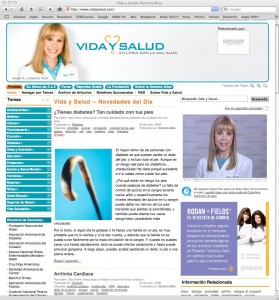
VidaySalud.com homepage
Photos: VidaySalud.com
In early June, Aliza Lifshitz, M.D., known to some Spanish speakers in the United States as la Doctora Aliza, launched VidaySalud.com, a Spanish-language health oriented website. About 20 percent of the content of the website, the Salud de A a Z section, is Spanish language translations from Harvard Health Publications. The remaining 80 percent is original content.
Editor Ana María Hanssen is responsible, with the help of five contributors, Carolina Dueñas, Natalia Jaramillo, Vanina Lombardi, Adriana Lozada and Francisco Stohr, for the editorial content of the portal. The publisher, Carl J. Kravetz, expects that over time the percent of original content will increase as daily articles are added to the website.
Kravetz, Lifshitz’ husband, also serves as the new website’s executive director. The two of them own the portal and portal copyrights are reserved to Cultural Asset Management Inc. The target audience is Latino mothers who are commonly considered the keepers of the health in Hispanic families. So far 60 percent of the registrations on the new website are from women. Sign ups have arrived from the United States as well as every country in Latin America and Spain.
“VidaySalud.com(TM) is the largest source of health information and wellness tools in Spanish on the web. It includes Health A to Z, the Harvard Medical School’s searchable database of symptoms, diseases and treatments, as well as original content, updated daily and created especially with the U.S. Hispanic community in mind,” said Lifshitz. “Our goal is to enhance the relationships between Latino patients and their physicians by giving Hispanics the information, tools and skills they need to better communicate with their doctors, to ensure better compliance with physician instructions and to deliver better health outcomes.”
VidaySalud.com includes channels on kids’, teens’, men’s and women’s health, diet and nutrition, exercise, pregnancy, diabetes, heart health, cancer, stress and mental health, sexual health, health insurance, health and beauty and healthy living. There is also a section on Quackery to inform users about how to protect themselves from unscrupulous promoters of unproven cures, remedies, diets and nutritional supplements. Eleven biweekly email newsletters on a variety of health topics are available through free registration.
“No one is more trusted on health by the Latino community than la Doctora Aliza,” said Kravetz. “With her as editor in chief and with science-based content delivered in the warm, caring style she is known for, VidaySalud.com will be an invaluable resource for Latino families.”
Promotion of the portal, including an active public relations program, will be focused on the site’s main target audience, Spanish speakers living in the United States. The company plans to announce joint initiatives with Ser Padres, People en Español, impreMedia and Univision. Doctora Aliza blogs’ on AOL Latino and Univision Radio link to the new website. The portal has co-branded its Niños (children) and Embarazo (pregnancy) pages with Ser Padres and the two publications will promote them together.
There are also plans for periodic health campaigns in partnership with the traditional media that Dra. Aliza works with. Her articles in impreMedia, People en Español and Ser Padres refer readers to the site. In addition, a partnership for the portal to become a resource for doctors and their Latino patients is in the works.

Aliza Lifshitz, M.D.
Lifshitz, a physician, author and health reporter, is involved with the Univision television network’s Peabody Award-winning health initiative Enterate: Salud es Vida. She also appears on the network’s Primer Impacto program. Her live call-in program, El Consultorio de la Dra. Aliza, airs weekly on the Univision Radio network.
She writes regular monthly columns for People en Espanol and for Ser Padres, and her weekly column is syndicated in Spanish-language newspapers nationwide. Her monthly column in the Vista bilingual supplement runs in 29 newspapers nationwide. In addition to her activities in the media, Dr. Lifshitz maintains a full-time private practice in internal medicine at Cedars-Sinai Medical Center in Los Angeles.
“Latino Family Dynamics” audio recording


Brenda Hurley and Liria Barbosa
Discuss
- Latino purchasing habits and products they favor
- Latino family characteristics
- Latinos and extended families
- Division of duties, responsibilities within the family
- Who is the decision maker in the Latino family
- Who is the information provider in the Latino family
Click here to find out about Latino purchasing habits and “Latino Family Dynamics”
Posted by Elena del Valle on June 12, 2009
Article and photo by Fredwill Hernandez
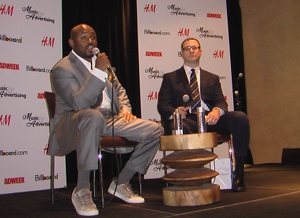
Steve Stoute, founder, Translation, LLC with Bill Werde, editorial editor, Billboard
On June 4 and 5, 2009 Billboard and Adweek partnered to host the first conference catered to music and advertising. The two day Music and Advertising Conference held at the W hotel in New York brought together industry insiders of the music and advertising world which focused on the importance of music incorporated in commercials and advertising campaigns. Thirty-one sponsors like Studio Media Group, H & M, and Sonicbids, along with the panelists and 400 people attendees heard presentations about making the connection between music brands and bands.
Conference highlights included a question and answer session with Bill Werde, editorial editor, Billboard and Steve Stoute, founder and chief creative officer, Translation LLC. Stoute was responsible for doing Chris Brown’s Wrigley gum deal stated that client Brown may still have a shot, in reference to his client’s run in with the law. He announced Translation recently signed Lady Gaga and plans to treat her as a brand.
Another conference highlight was a sit down with Pharrel Williams, the Neptunes, producer and front man who recently partnered with Cornerstone to create a new agency. He spoke about how Teddy Riley, producer and front man for R&B group Guy gave him his first brake. Williams elaborated on how his deal and ad campaign for Converse shoes came about.
As record sales have declined music record companies and artists have looked at other ways to offset costs and new ways to make revenues. According to panelist David Keefer, global director, Media and Entertainment, Siegel and Gale simplified branding as “what you think, feel, and visual experience you get, or as what you hear, taste and touch.”
The conference emphasized the importance of music and branding, and how many acts have benefited and piggy backed off of branding opportunities. One such act was Australian duo The Veronicas who spoke on how they contributed music and how their music took off after they helped Bayer brand Yaz, a birth control pill.
Fredwill Hernandez, president, Spanglish Entertainment LLC, is a musician and aspiring journalism student who expects to attend California State University Dominguez Hills in Los Angeles, California.
Posted by Elena del Valle on June 10, 2009

Michael Zuccato, General Manager of Cuba Travel Services, Inc.
Photo: Cuba Travel Services
Cuba Travel Services, Inc., a Long Beach, California company owned by “a group of Los Angeles business people” will launch a non-stop weekly flight from Los Angeles to Havana, Cuba starting June 30, 2009. The inaugural flight is 50 percent sold as of this writing. Havana bound departures will be Tuesdays at 11 a.m. and returns to Los Angeles will be at 8:25 p.m. the same day.
The company will be utilizing aircraft operated by Continental Airlines with space for up to 150 passengers, 12 First Class and 138 Coach. The five-hour flights will cost $889 and include up to 60 pounds of Licensed Passenger Check Baggage. First Class tickets will cost $1,395.
“We are excited to resume the non-stop flights out of LAX to Havana that were in such high demand prior to the Bush Administration’s restrictions imposed on Cuban Americans that limited their ability to visit with their families in Cuba,” said Michael Zuccato, general manager of Cuba Travel Services, Inc.
Company executives expect the recent policy changes allowing easier travel to Cuba for Cuban Americans brought on by the Obama Administration will drive demand for travel to the island from the West Coast. Cuba Travel Services, Inc. also hopes to serve the travel needs of journalists, government officials and researchers that qualify under a general license; and sports teams, religious organizations, educational facilities and other organizations or individuals who qualify for and are issued a specific license to travel.
Cuba Travel Services, Inc. has been offering direct charter flights from Los Angeles to Havana since 2000. According to the data supplied by them, in 2003, the United States ranked eighth in visitors per country of origin to Cuba with 84,529 visitors; by 2005 only 37,233 travelers were visiting the island.
Cuba Travel Services Inc. was formed to “facilitate a better understanding between the U.S and Cuba” by providing flights to U.S. citizens who qualify under the current U.S. Treasury regulations. Cuba Travel Services Inc has offices in Doral and Hialeah, Florida and Hato Rey, Puerto Rico. The company has more than 20 employees.
“Latino Family Dynamics” audio recording


Brenda Hurley and Liria Barbosa
Discuss
- Latino purchasing habits and products they favor
- Latino family characteristics
- Latinos and extended families
- Division of duties, responsibilities within the family
- Who is the decision maker in the Latino family
- Who is the information provider in the Latino family
Click here to find out about Latino purchasing habits and “Latino Family Dynamics”
Posted by Elena del Valle on June 8, 2009
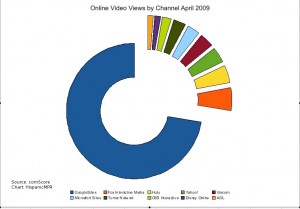
Videos Viewed Online April 2009 - click to enlarge
An epidemic is sweeping the country. No, not the flu. It’s videos. Online. Now that broadband Internet is widely available Americans seem to have fallen in love with videos. Although these are mostly short clips, 3.5 minutes on average, billions of videos were viewed around the country in the past months. In April 2009, for example, Americans viewed 16.8 billion videos online, including 6.8 billion videos viewed on Google. The average U.S. viewer watched 6.4 Hours video online that month, according to comScore Video Metrix. This represents a 16 percent increase compared to March 2009. ComScore analysts believe the increase was driven by a surge in viewing on YouTube.
YouTube.com accounted for more than 99 percent of all videos viewed at the property. Fox Interactive Media ranked second with 513 million videos (3.1 percent), followed by Hulu with 397 million (2.4 percent) and Yahoo! Sites with 355 million (2.1 percent).
In the United States, 152 million Internet users watched an average of 111 videos per viewer in April 2009. Google Sites reached an all-time high of 107.9 million video viewers during the month. Fox Interactive Media ranked second with 58.8 million viewers, followed by Yahoo! Sites (45.4 million) and Hulu (40.1 million).
ComScore researchers concluded that 78.6 percent of the U.S. Internet audience viewed videos online. A closer look reveals that 107.1 million viewers watched 6.8 billion videos on YouTube.com or about 63.5 videos per viewer; 49 million viewers watched 387 million videos on MySpace.com or 7.9 videos per viewer. Hulu accounted for 2.4 percent of videos viewed and 4.2 percent of all minutes of online video viewing.
A Virginia based company, comScore measures digital media usage. The company’s capabilities are based on a large international cross-section of 2 million Internet users who allow comScore to confidentially capture their browsing and transaction behavior, including online and offline purchasing.
“Moving Beyond Traditional Media Measurement: measuring conversations and social media” audio recording

Presenter Katie Delahaye Paine, founder, KDPaine & Partners
Find out about
- Issues affecting online public relationships today
- Testing relationships as part of a survey
- Measuring ethnic group relationships
- Measuring foreign language communications in a similar ways to English
- Biggest challenges measuring conversations and social media
- Measuring online relationships with little or no money
Click here for information on “Moving Beyond Traditional Media Measurement”





























